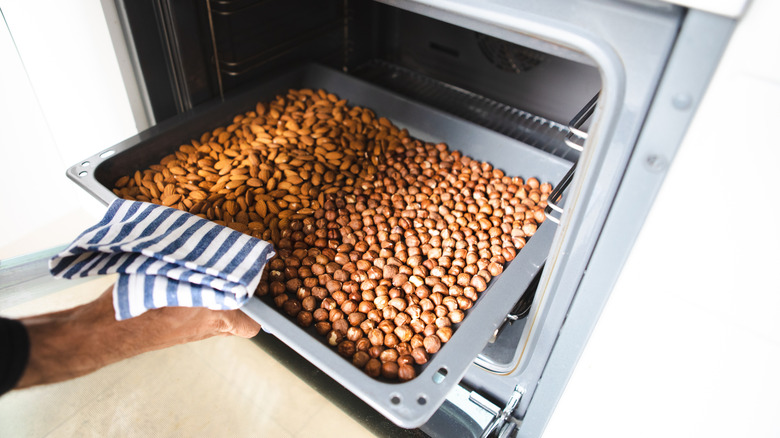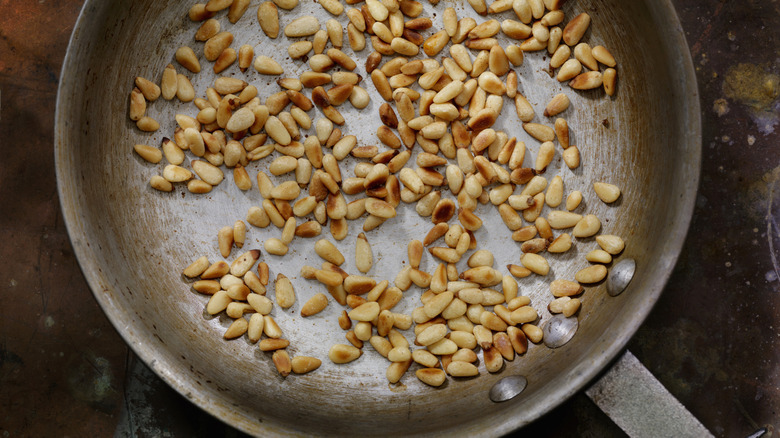Oven Vs Stovetop: Where's The Best Place To Roast Nuts?
You're missing out if you aren't toasting nuts for your salads or soups. This culinary technique brings out their nutty aroma, elevates their texture, and releases their natural oils, which imbues them with a complex character and rounded flavor. Roasted nuts can transform a homemade granola, upgrade a basic trail mix, and make a scrumptious on-the-go snack when seasoned with savory spices. While commonly roasted in the oven, nuts can also be warmed through on the stovetop in a hot skillet. But which method is the best? The answer lies in the specific needs of your recipe, your time considerations, and the variety and size of nuts you're working with.
Cooking nuts on the stovetop is sometimes described as toasting rather than roasting. Roasting is a slow cooking process that totally transforms the entire texture of a nut whereas toasting is faster and mostly affects the exterior and edges. However, both moves have their pros and cons and can be equally as effective, depending on what your end goal is. For example, you may want to oven roast an entire bag of peanuts to make a large batch of brittle but prefer to use the stovetop to lend texture to several blanched and slivered almonds for topping a carrot cake. Nuts can be roasted as they are without additional ingredients, which is known as dry roasting, or baked with a slick of oil and seasonings.
The oven is perfect for roasting large quantities of nuts
Roasting nuts in the oven is a power move if you're preparing a hefty amount of hazelnuts or cashews, as you can spread them out evenly across the surface area of a large sheet pan versus a small skillet. Secondly, you can largely leave your nuts pretty much unmonitored, which frees you up to prepare other elements of your meal. While you will need to give your nuts a quick toss halfway through the cook-time to guarantee every bit of surface area is toasted, the balanced heat from the oven will encourage them to develop an even color without scorching.
A lower and slower stint in the oven also allows nuts of a larger size and thickness to warm through to the middle, resulting in a crisper texture, sweeter character, and rich, nutty fragrance. For instance, the best method for toasting walnuts is the oven because they have a bigger surface area than petite varieties of nuts, like pine nuts and pistachios. Just be mindful that slivered or chopped almonds and pistachios can burn rapidly, so don't be tempted to venture off too far. The biggest mistake people make when roasting nuts is to mix a variety together on the same sheet pan. This is a problem because smaller nuts, like cashews, will cook through faster than larger ones, such as macadamias, and burn at the edges, resulting in a bitter and unpalatable taste.
The stovetop is ideal for small amounts of slivered nuts
If you're making a small batch of toasted nuts to top a green bean casserole or homemade soup, roasting them in a pan on the stovetop is your best bet (busting out your sheet pan to roast a single handful of pecans just doesn't make sense when preparing super-small quantities). The main benefit of this technique is speed; you won't need to wait for an oven to preheat and can simply toss your nuts of choice into your skillet and stir them around as they develop a golden color and toasty character, which can take anything from one to five minutes. However, be mindful that the concentrated and focused heat from the burner will require you to monitor your nuts at all times so you can move them around and prevent any spots from burning. For greater control, start your nuts in a cold skillet so their centers can heat through as their exteriors toast.
A stovetop toast is ideal for slivered almonds or chopped nuts because they heat through faster than whole nuts. Better yet, you can create a customized mixture by simply waiting for larger nuts to develop some color before tossing in any finer ones for the final minute or so.


